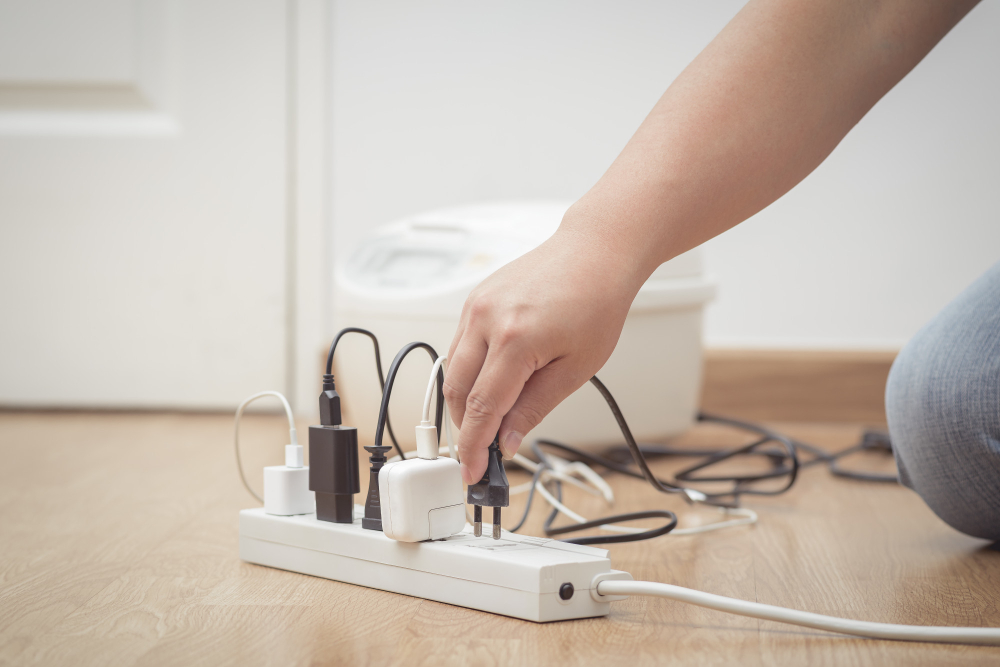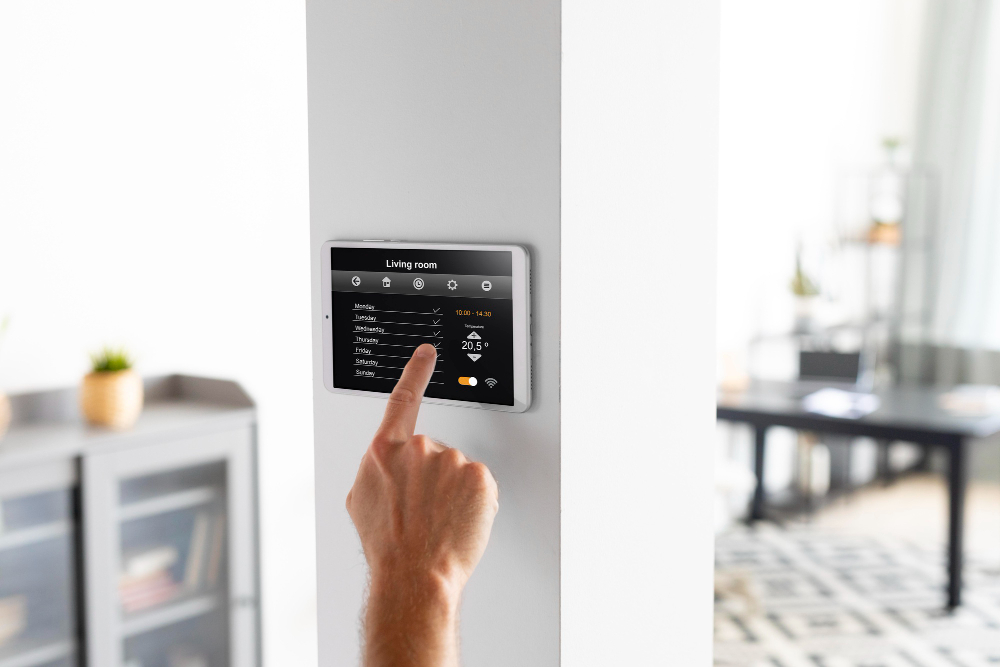Simple home changes that add up to big savings.

Cutting expenses doesn’t always require drastic lifestyle changes—sometimes, small adjustments at home can add up to significant savings. By tweaking your daily habits, optimizing energy use, and making smarter purchasing decisions, you can easily save $200 or more each month.
These changes won’t require you to sacrifice comfort or convenience. Here are 11 small but impactful ways to trim your household budget.
1. Unplug unused electronics.

Many devices continue to draw power even when turned off, leading to unnecessary electricity costs. Chargers, gaming consoles, and kitchen appliances are common culprits of this “phantom” energy drain. Unplugging them when not in use or using a smart power strip can help reduce energy waste and lower your electricity bill.
Additionally, some electronics, like computers and televisions, use standby power that adds up over time, according to House Logic. A simple habit of switching off power strips at night or when leaving the house can save you up to $20 a month. Making this small change not only conserves energy but also extends the lifespan of your devices.
2. Adjust your thermostat wisely.

Heating and cooling costs can take a big bite out of your monthly budget. Setting your thermostat a few degrees lower in winter and higher in summer can lead to substantial savings. Programmable thermostats or smart models allow you to automate temperature changes based on your schedule, ensuring efficiency without compromising comfort, according to Kinda Frugal.
Wearing season-appropriate clothing and using blankets in colder months can also help reduce the need for excessive heating. During warmer seasons, utilizing fans and closing blinds to block sunlight can keep your home cooler without relying heavily on air conditioning. These simple changes can shave off $30 or more from your utility bill.
3. Cook at home more often.

Eating out or ordering takeout adds up quickly, often costing two to three times more than preparing meals at home. Planning your weekly menu, cooking in batches, and utilizing leftovers can help you cut your food expenses significantly while also ensuring healthier meals.
Investing in a slow cooker or air fryer can make meal prep easier and more convenient, reducing the temptation to eat out. Additionally, learning a few budget-friendly recipes can keep your meals interesting without breaking the bank. Cutting back on restaurant visits by just a few meals a week can save you at least $50 monthly.
4. Use energy-efficient lighting.

Traditional incandescent bulbs consume more electricity and burn out faster than LED alternatives. Switching to LED bulbs not only reduces your energy usage but also lowers the frequency of replacements, saving you money in the long run. These bulbs use up to 75% less energy and last significantly longer.
Beyond bulbs, maximizing natural light by opening curtains during the day can reduce your reliance on artificial lighting. Additionally, turning off lights in unoccupied rooms and using dimmer switches or motion sensors can help lower your energy consumption further. Making these changes can trim about $10 off your electricity bill each month.
5. Reduce water waste.

Many households unknowingly waste gallons of water daily, which leads to higher utility bills. Installing low-flow showerheads and faucet aerators can cut your water usage without sacrificing pressure. Fixing leaks promptly also prevents unnecessary water loss, reducing both your water bill and environmental impact.
Another way to save is by being mindful of water use during daily tasks. Running full loads in the dishwasher and washing machine instead of half loads, turning off the tap while brushing your teeth, and using collected rainwater for outdoor plants are small habits that can save you around $15 per month.
6. Cancel unused subscriptions.

Many people sign up for streaming services, memberships, or premium apps and forget about them over time. Reviewing your monthly statements to identify unused or rarely used subscriptions can help you trim unnecessary expenses. Canceling just one or two services can quickly add up to substantial savings.
Consider sharing streaming accounts with family members or opting for free alternatives where possible. Some services also offer discounts if you downgrade to a lower-tier plan. Regularly auditing your subscriptions ensures you’re only paying for what you truly use, potentially saving you $25 or more each month.
7. Cut down on paper towel usage.

Paper towels are convenient but can be an expensive habit over time. Switching to reusable microfiber cloths or washable kitchen towels reduces the need for disposable paper products, saving both money and waste. Keeping a set of reusable rags on hand for spills and cleaning makes the transition seamless.
Additionally, using sponges or silicone scrubbers instead of disposable wipes for kitchen cleaning can further reduce costs. While it may take time to get used to, cutting back on paper towel consumption can easily save you $10 or more per month, while also being more eco-friendly.
8. Shop smarter for groceries.

Impulse buying and lack of meal planning can lead to overspending at the grocery store. Creating a shopping list and sticking to it helps you avoid unnecessary purchases. Buying in bulk, choosing store-brand items, and utilizing coupons or cashback apps can make a noticeable difference in your grocery bill.
Another tip is to shop with a full stomach—hunger often leads to unnecessary spending. Additionally, opting for seasonal produce and frozen goods can cut costs without sacrificing nutrition. With a few mindful shopping habits, you can easily save $40 or more on groceries each month.
9. Wash clothes in cold water.

Heating water for laundry significantly increases your energy bill. Most modern detergents are designed to work effectively in cold water, making hot washes unnecessary for most loads. Switching to cold water for your laundry can reduce energy consumption without affecting cleanliness.
Additionally, air-drying clothes instead of using a dryer can save even more money. If you do use a dryer, cleaning the lint trap regularly and drying multiple loads back-to-back can improve efficiency. These simple laundry habits can cut down your energy costs by at least $10 per month.
10. DIY basic home maintenance.

Hiring professionals for minor home repairs and maintenance can quickly add up. Learning how to handle simple tasks like unclogging a drain, patching small holes in walls, or fixing a leaky faucet can save you a lot of money over time. Many tutorials are available online to guide you step by step.
Keeping up with regular maintenance, like cleaning HVAC filters or sealing windows to improve insulation, can prevent costly repairs down the line. Having a basic toolkit and developing DIY skills can reduce home maintenance expenses by at least $30 per month.
11. Limit impulse spending.

Online shopping and retail therapy can drain your budget without you realizing it. A simple trick to curb impulse purchases is implementing a 24-hour rule—waiting a day before buying non-essential items. This helps you determine whether the purchase is truly necessary.
Unsubscribing from promotional emails and removing saved payment methods from online stores can also prevent unnecessary spending. Setting a monthly budget for discretionary expenses ensures you stay financially on track. Reducing impulse buys can save you well over $50 each month.
